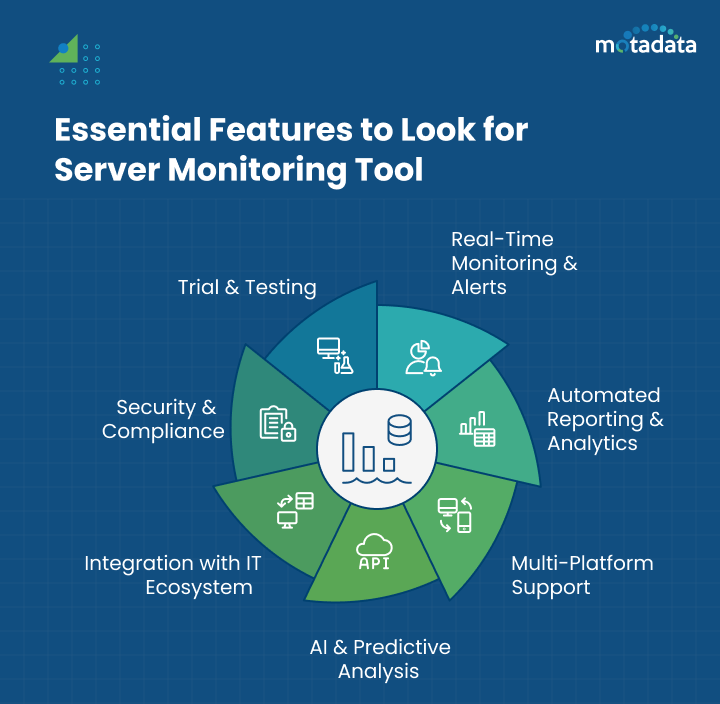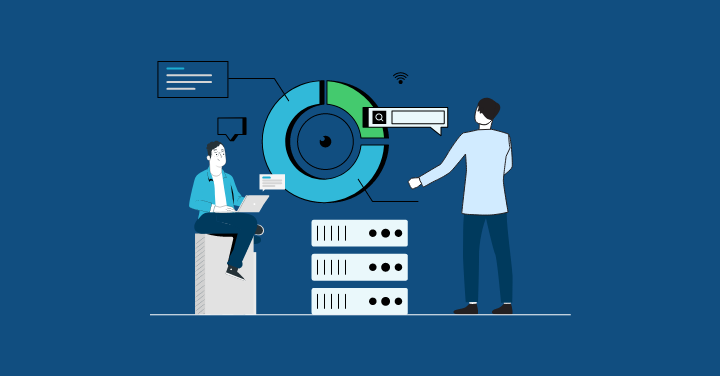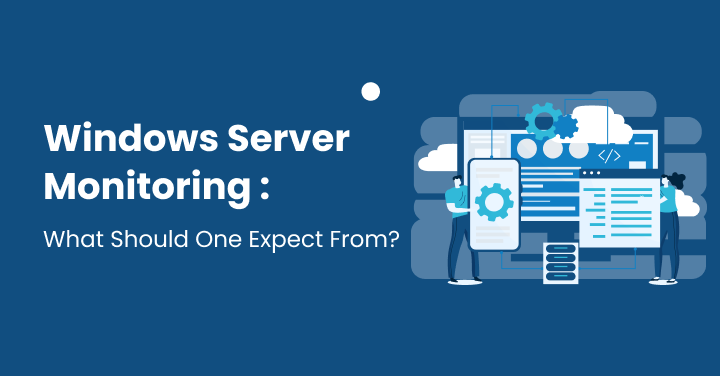Introduction
Businesses today rely on seamless online experiences, making robust server monitoring essential. It ensures that IT infrastructure remains optimized and applications function correctly.
Organizations can proactively address performance issues and minimize downtime by tracking key performance indicators (KPIs) such as CPU usage, memory consumption, and network traffic.
Understanding Your Business Needs
Before selecting a server monitoring tool, it is crucial to define your business requirements. Infrastructure type, critical performance metrics, and budget are vital in determining the best solution.
Each business has unique needs based on its IT setup, making it necessary to assess what kind of monitoring approach will best suit its infrastructure and operational goals.
Assessing Your Infrastructure: On-Premises, Cloud, or Hybrid
Understanding your server environment is the first step in making an informed decision. Different infrastructures require different monitoring solutions, and knowing where your servers are hosted will help you find the most suitable tool.
If your organization relies on an on-premises infrastructure, you need a tool that provides deep hardware integration, allowing you to monitor hardware components, server processes, and internal networking with detailed insights. These tools ensure that every physical server component is accounted for and maintained efficiently.
For businesses that operate in the cloud, a monitoring solution must be compatible with cloud provider platforms such as AWS, Azure, or Google Cloud. Cloud environments are dynamic and require a monitoring system that can scale up or down based on real-time demand.
Cloud-native monitoring tools offer integrations with cloud service providers, enabling businesses to track instances, containers, and microservices effectively.
Identifying Key Metrics: CPU, Memory, Disk Usage
Selecting a server monitoring tool means focusing on the right performance metrics to maintain smooth operations.
While monitoring solutions provide a vast array of data points, it is essential to concentrate on key performance indicators that directly impact system performance and stability.
CPU usage is one of the most critical metrics to track. High CPU utilization can indicate an overloaded server, which may result in slower application performance or system crashes.
A well-optimized monitoring tool should offer real-time alerts when CPU usage surpasses safe thresholds, helping IT teams act proactively before performance issues escalate.
Memory consumption is another vital metric, as insufficient memory can lead to system slowdowns and unresponsive applications.
Monitoring tools should provide clear insights into memory utilization, helping IT administrators allocate resources efficiently and prevent resource exhaustion.
Disk space is often overlooked, but it plays a crucial role in system stability. Running out of disk space can lead to performance bottlenecks and failures, particularly for databases and applications that require continuous data storage.
Server monitoring tools should offer disk usage analytics, sending alerts when available storage reaches critical levels.
Defining Your Budget and Scalability Needs
Businesses need to balance affordability with functionality, ensuring that they invest in a solution that provides value without unnecessary expenses.
Free and open-source server monitoring tools can be an excellent option for startups or small businesses with limited budgets.
These tools often come with strong community support and customization options, making them ideal for tech-savvy teams that can configure and maintain them independently.
However, they may lack advanced features, dedicated support, and seamless integrations found in premium solutions.
On the other hand, enterprise-grade monitoring software often comes at a higher cost but provides a comprehensive set of features, including real-time analytics, AI-driven insights, automation, and 24/7 customer support.
For large organizations with complex IT environments, investing in a paid solution may be more beneficial in the long run, as it reduces operational overhead and ensures reliable performance monitoring.
Essential Features to Look for
1. Real-Time Monitoring & Alerts
Instant visibility into server performance is crucial for maintaining smooth operations. A good server monitoring tool should offer live dashboards that display real-time performance metrics.
Additionally, it should provide robust alerting mechanisms that notify IT teams through multiple channels such as email, SMS, or collaboration platforms like Slack. This ensures that potential issues are addressed before they escalate into major problems.
2. Automated Reporting & Analytics
To avoid being overwhelmed by raw data, an effective monitoring solution should generate automated reports and provide in-depth analytics. These reports help IT teams understand historical performance trends and detect patterns that might indicate potential failures.
Predictive analytics is an added advantage, allowing organizations to troubleshoot issues proactively and optimize server performance over time.
3. Multi-Platform Support
A versatile server monitoring tool should support various environments, including Windows and Linux, ensuring flexibility across different infrastructures. Furthermore, modern IT setups often include virtual machines and containerized applications.
The monitoring solution should integrate seamlessly with virtual machines and container orchestration platforms, providing comprehensive visibility into all computing resources.
4. AI & Predictive Analysis
Advanced server monitoring solutions now leverage AI to predict potential failures before they occur. AI-driven insights help detect anomalies in server performance, allowing businesses to take preventive measures.
Predictive analytics recommends performance optimizations, ensuring that resources are used efficiently while reducing the likelihood of downtime. By incorporating machine learning capabilities, these tools make server monitoring more intelligent and proactive.
5. Integration with Existing IT Ecosystem
A server monitoring tool should seamlessly integrate with your existing IT workflows, ensuring smooth operations and improved efficiency.
Compatibility with IT Service Management (ITSM) and DevOps tools is essential. Solutions like ServiceNow and Jira enable automated ticketing and streamlined issue resolution, reducing response times and enhancing workflow efficiency.
APIs and third-party integrations play a crucial role in modern IT ecosystems. A monitoring tool with robust API support allows for custom automation, enabling IT teams to configure alerts, reports, and workflows tailored to their specific operational needs.
Integrating with third-party applications enhances visibility, optimizes performance tracking, and simplifies overall infrastructure management.
6. Security & Compliance Considerations
With cyber threats on the rise, selecting a secure server monitoring solution is critical. Strong security features such as end-to-end encryption help safeguard sensitive data, ensuring that information remains protected during transmission and storage.
Role-Based Access Control (RBAC) is another essential security feature, restricting access to specific users based on their roles within the organization, thereby preventing unauthorized access and reducing internal risks.
Compliance with industry standards such as GDPR, HIPAA, and ISO 27001 is also crucial. Businesses handling sensitive customer data must ensure that their monitoring solution adheres to these regulations to avoid legal repercussions and maintain data integrity.
7. Trial & Testing Before Finalizing
Before committing to a monitoring solution, it is advisable to conduct hands-on testing. Many vendors offer free trials or demo versions, allowing businesses to evaluate the tool’s capabilities in their specific environment.
Testing ensures that the solution meets technical and operational requirements while providing an intuitive user interface for IT teams.
Running a test environment, such as a sandbox, can help replicate real-world conditions, allowing teams to uncover potential integration challenges before deployment.
This process enables IT teams to refine configurations, optimize workflows, and ensure seamless integration with existing systems.
Conclusion
Selecting the right server monitoring tool is a strategic decision that significantly impacts system stability and performance. Businesses must assess their infrastructure needs, define key performance metrics, and ensure that the chosen solution aligns with their budget and scalability requirements.
Essential features such as real-time monitoring, automated reporting, multi-platform support, and AI-driven insights play a crucial role in enhancing efficiency and minimizing downtime.
When evaluating solutions, organizations should weigh the benefits of open-source versus commercial tools, considering factors such as cost, ease of use, and support.
Integration with existing IT workflows and compliance with industry standards are equally important in making a well-rounded choice.
To ensure a successful implementation, businesses should take advantage of free trials and test environments to validate the tool’s effectiveness.
Investing in the right server monitoring tool will enhance IT operations, prevent critical failures, and support long-term business growth.
Now is the time to take proactive steps in securing and optimizing your IT infrastructure with a reliable monitoring solution.
FAQs:
A solution that tracks server health, performance, and network activity to ensure optimal functionality.
It prevents downtime, improves performance, and provides critical insights into IT infrastructure.
- Real-time monitoring
- Customizable dashboards
- Automated reporting
- Scalability
- Integration with IT tools
Yes, most tools offer APIs and third-party integrations to streamline workflows and enhance data visibility.
By choosing the right server monitoring solution, businesses can optimize IT operations and ensure smooth digital experiences for users.








